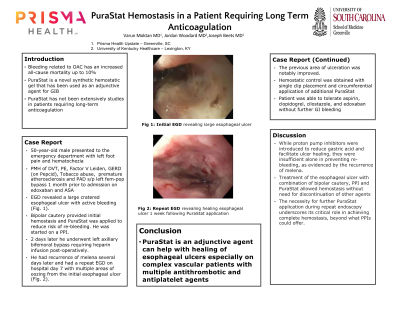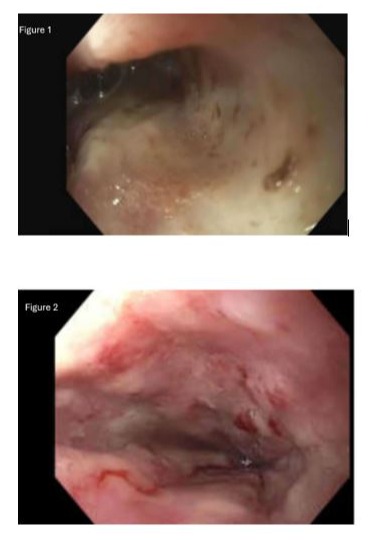Tuesday Poster Session
Category: GI Bleeding
P4247 - PuraStat Hemostasis in a Patient Requiring Long Term Anticoagulation
Tuesday, October 29, 2024
10:30 AM - 4:00 PM ET
Location: Exhibit Hall E

Has Audio
- VM
Varun Moktan, MD
Prisma Health, University of South Carolina School of Medicine
Greenville, SC
Presenting Author(s)
Varun Moktan, MD1, Jordan Woodard, MD2, Joseph Beets, MD3
1Prisma Health, University of South Carolina School of Medicine, Greenville, SC; 2University of Kentucky College of Medicine, Lexington, KY; 3Prisma Health Greenville Memorial Hospital, Greenville, SC
Introduction: Frequency of gastrointestinal bleeding (GIB) are increased by medications including oral anticoagulation (OAC). Bleeding related to oral anticoagulation has an increased all-cause mortality up to 10%. This increased mortality necessitates urgent intervention for hemostatic control, but also to allow for restarting OAC to prevent risk associated with prolonged holding of OAC. PuraStat is a novel synthetic hemostatic gel that has been used as an adjunctive agent for GIB. However, it has not been studied extensively in populations with patients on long-term anticoagulation.
Case Description/Methods: A 50-year-old male presented to the emergency department with left foot pain and hematochezia. His past medical history was notable for deep venous thrombosis, pulmonary embolism, factor V Leiden, premature atherosclerosis, and peripheral arterial disease status post left femoropopliteal bypass graft. 1 month prior to admission he underwent an angiogram with right Superficial femoral artery (SFA) occlusion and had been on Edoxaban and Aspirin.
His Hemoglobin dropped from 9.3 to 6.1 g/dL. He received IV pantoprazole and 1 unit pack red blood cells.. He had an emergent EGD which revealed a large cratered esophageal ulcer with active bleeding (Fig. 1). Bipolar cautery provided initial hemostasis and PuraStat was applied to reduce risk of re-bleeding.
2 days later he underwent left axillary bifemoral bypass requiring heparin infusion post-operatively. He had recurrence of melena several days lays though hemoglobin remained stable without need for additional blood transfusions. A repeat EGD was performed on hospital day 7 revealing oozing from the initial esophageal ulcer (Fig. 2). The previous area of ulceration was notably improved. Hemostatic control was obtained with single clip placement and circumferential application of additional PuraStat.
No further complications of GI bleeding were reported during the hospitalization, and he was discharged on Aspirin, Clopidogrel, Cilostazole, and Edoxaban which he continues today without further GI complications.
Discussion: Gastrointestinal bleeding is a common complication of anticoagulation and can limit the ability adequately treat vascular diseases. Our patient was able to tolerate dual-antiplatelet therapy and anticoagulation following a femoral bypass after esophageal ulcer treatment with PuraStat based hemostatic control. He additionally had improvement in the previous esophageal ulcer site showing tissue healing within 1 week of treatment.

Disclosures:
Varun Moktan, MD1, Jordan Woodard, MD2, Joseph Beets, MD3. P4247 - PuraStat Hemostasis in a Patient Requiring Long Term Anticoagulation, ACG 2024 Annual Scientific Meeting Abstracts. Philadelphia, PA: American College of Gastroenterology.
1Prisma Health, University of South Carolina School of Medicine, Greenville, SC; 2University of Kentucky College of Medicine, Lexington, KY; 3Prisma Health Greenville Memorial Hospital, Greenville, SC
Introduction: Frequency of gastrointestinal bleeding (GIB) are increased by medications including oral anticoagulation (OAC). Bleeding related to oral anticoagulation has an increased all-cause mortality up to 10%. This increased mortality necessitates urgent intervention for hemostatic control, but also to allow for restarting OAC to prevent risk associated with prolonged holding of OAC. PuraStat is a novel synthetic hemostatic gel that has been used as an adjunctive agent for GIB. However, it has not been studied extensively in populations with patients on long-term anticoagulation.
Case Description/Methods: A 50-year-old male presented to the emergency department with left foot pain and hematochezia. His past medical history was notable for deep venous thrombosis, pulmonary embolism, factor V Leiden, premature atherosclerosis, and peripheral arterial disease status post left femoropopliteal bypass graft. 1 month prior to admission he underwent an angiogram with right Superficial femoral artery (SFA) occlusion and had been on Edoxaban and Aspirin.
His Hemoglobin dropped from 9.3 to 6.1 g/dL. He received IV pantoprazole and 1 unit pack red blood cells.. He had an emergent EGD which revealed a large cratered esophageal ulcer with active bleeding (Fig. 1). Bipolar cautery provided initial hemostasis and PuraStat was applied to reduce risk of re-bleeding.
2 days later he underwent left axillary bifemoral bypass requiring heparin infusion post-operatively. He had recurrence of melena several days lays though hemoglobin remained stable without need for additional blood transfusions. A repeat EGD was performed on hospital day 7 revealing oozing from the initial esophageal ulcer (Fig. 2). The previous area of ulceration was notably improved. Hemostatic control was obtained with single clip placement and circumferential application of additional PuraStat.
No further complications of GI bleeding were reported during the hospitalization, and he was discharged on Aspirin, Clopidogrel, Cilostazole, and Edoxaban which he continues today without further GI complications.
Discussion: Gastrointestinal bleeding is a common complication of anticoagulation and can limit the ability adequately treat vascular diseases. Our patient was able to tolerate dual-antiplatelet therapy and anticoagulation following a femoral bypass after esophageal ulcer treatment with PuraStat based hemostatic control. He additionally had improvement in the previous esophageal ulcer site showing tissue healing within 1 week of treatment.

Figure: Figure 1 - Initial EGD with large esophageal ulcer
Figure 2 - Repeat EGD with healing esophageal ulcer
Figure 2 - Repeat EGD with healing esophageal ulcer
Disclosures:
Varun Moktan indicated no relevant financial relationships.
Jordan Woodard indicated no relevant financial relationships.
Joseph Beets indicated no relevant financial relationships.
Varun Moktan, MD1, Jordan Woodard, MD2, Joseph Beets, MD3. P4247 - PuraStat Hemostasis in a Patient Requiring Long Term Anticoagulation, ACG 2024 Annual Scientific Meeting Abstracts. Philadelphia, PA: American College of Gastroenterology.
